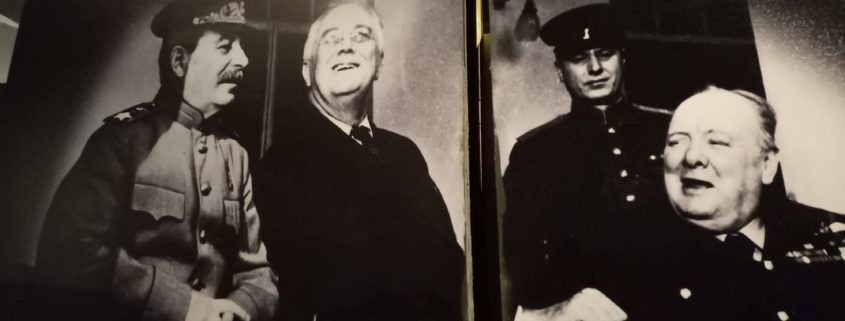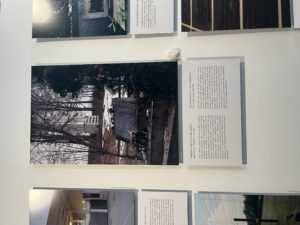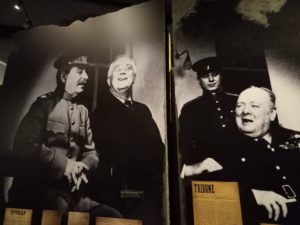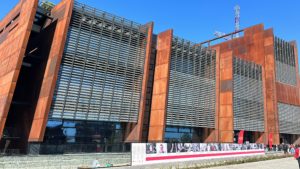“Forum” and “Shrine”: A Tool for Analyzing Museums
By Sofia DaCruz
I have visited many museums in my life, subconsciously consuming the collections and messages they portray with little analysis of their function or purpose. As we have moved through museums in Poland, guided by questions and discussions about their purposes, I have found a new lens to examine museums beyond their literal exhibitions. What has been essential to this lens is the question: are museum’s a “forum or a shrine”? A shrine indicates a commemoration and glorification of a historical moment, whereas a forum sparks conversation and forward thinking. The juxtaposition of the concepts “forum” and “shrine” create a series of questions for a deeper examination of museums. In order to view a museum as a “forum” or “shrine,” we must first ask: Why was this museum created? Who is it for? How is it embedded in its community? What purpose does the museum serve through and beyond its exhibitions?
The Galicia Jewish Museum is located in a small building in Kazimierz, the Jewish quarter of Krakow, embedded in the history that it represents. The museum is dedicated to the Jewish past in the historic region of Galicia, encompassing both a commemoration of the holocaust and a celebration of Jewish life. When entering the museum, I first noticed the small cafe and a bookstore, open to members of the public who might not necessarily intend to visit the exhibit. We then walked through a room with photos lining the walls to get to a classroom. There, Katarzyna Suszkiewicz, the head of the Education Department, greeted us. She outlined and discussed the museum’s work with Ukrainian refugees, which includes employment, educational programs for children, language classes, and programs for the elderly. Throughout this discussion I noticed how little she mentioned the museum’s exhibit, instead focusing on programs involving the local community. When it was time to visit the exhibit we were guided by one of the museum’s interns. Throughout his tour I noticed that he wasn’t reciting a script but providing more personal knowledge into what specifically interested him. After our tour of the exhibit the guide joined us for lunch, where we discussed his personal experiences in the German education system and the current political situation and rise of nationalism in Germany. The opportunity to engage with him beyond the exhibit created an educational experience reflective of the work that the museum does in its community. When considering the concepts of “forum” and “shrine”, the Galicia Jewish museum provides more than just a forum through its community-focused programs. It is important to consider why a museum focusing on Jewish history would play a role beyond its literal exhibit “enshrining” Jewish history. With the destruction of Jewish life during the holocaust, it is necessary that the museum plays a role in maintaining Jewish presence in Kazimierz through various cultural events. Similarly, the efforts to aid refugees reflects learning lessons from history and the importance of action rather than silence, especially in times of war. The concepts of “forum” and “shrine” provide a framework for analysis of how the Galicia Jewish Museum functions within its community out of a need for revitalization of Jewish history and action for refugees.
The Warsaw Rising museum provided an experience quite different from that of the Galicia Jewish Museum. Before entering Warsaw Rising we were handed our tickets outside, a moment I found strange given that at most of the museums we have visited there is a reception space indoors. As we entered through the doors, I understood this museum’s distinct approach as I was immediately immersed in the sensory experience. The space was dark and the atmosphere was threatening with the sound of bombs exploding in the background. The museum was also crowded, and I felt a need to escape the chaos. My peers and I walked quickly through this first section and found ourselves lost among an overwhelming exhibit. The museum is overflowing with information about the 1944 Polish uprising against Nazi occupation, yet it lacks a story line with a clear beginning, or end creating an isolated “shrine” of the moment in history. I began to question why this museum sought to enshrine this specific historical event. Prior to the opening in 2004, the history of the Warsaw Uprising of 1944 was neglected. Under Stalinism, it was illegal to mention the event in the open. Perhaps this absence of knowledge and public discussion emphasized even more its importance to Polish identity, making this history worthy of being enshrined. But why not create a forum, a space for community engagement and education, or at least a story line? The Upsiring did not end in independence and victory, but communist occupation. Most of the historic old town was in ruins and 150,000 civilians were killed. Perhaps the decision to create a shrine points to the necessity of bringing attention to Polish heroism for cultivating national identity, especially when emerging from a traumatic history of multiple occupations. When walking through the Warsaw Rising museum the ideas of “forum” and “shrine” can be used as a tool for understanding Polish society and its desire for preserving and highlighting this specific moment in history.
The European Solidarity Center is another museum focused on a historical event, the emergence of the independent trade union and communist opposition movement known as Solidarity, located on the grounds of the former Gdansk Shipyard where Solidarity was founded. Walking through the doors of the European Solidarity Center I was met not with history, but with a bustling book fair. The first floor was filled with students pursuing books from different vendors. I quickly felt a sense of engagement as this community event was central and the museum’s main exhibit was nowhere in sight. After passing through the book fair, we were led up to a conference room where we were greeted by Jacek Koltan, the Director’s Representative for Research who guided us through the many lectures and discussions we had in this space. I found it interesting how we used this space for discussions about other museums such as the WWII museum, indicating that the other museum’s didn’t have an available meeting space for groups like ours. By facilitating these educational discussions and offering access to meeting rooms, the museum’s function expands beyond a historical exhibition. Before entering the exhibit itself, it was clear through its name, which does not use the word museum, that the European Solidarity Center is more than a “museum,” it is a space for educating and engaging the local community.
When entering the exhibit itself, I was surprised to find how empty it felt compared to the bustling book fair downstairs. In the exhibit I focused on the contents of the audio guide, which led me through a story beginning with the experience of workers at the Gdansk shipyard and ending with a white room projecting videos of multiple leaders of non-violent opposition movements, from Martin Luther King jr. to Mahatma Gandhi. I found this final room an interesting attempt to connect the history of Solidarity to other significant liberation movements from around the world. But the room, which is separated from the core exhibition, challenges visitors to consider not just the past, but also the future and the importance of non-violent movements to achieve social change. Although I found this final room to be somewhat confusing, armed with the concepts of “forum” and “shrine”, I was able to recognize that it was an attempt to create a “forum” out of the exhibit through a future focused element. What I found most interesting after the exhibit, was the opportunity to discuss our experiences with Jacek Koltan, who gave insight into the process of its creation and even critiqued its more experiential components. The Solidarity Center’s aspects of both a “shrine” in its exhibit and a “forum” in its community focused events indicates both a need to preserve the history of the Solidarity movement and a desire to maintain and perpetuate its ideals. Through the idea of a “forum” vs. “shrine,” the European Solidarity Center can be understood as an organization for both tourists and local community members, where the history of the Solidarity Movement is “enshrined” but in a way that fosters discussion through a variety of museum events. I used the ideas of “forum” and “shrine” to understand the dual function of the European Solidarity Center which is both a space that recounts history and preserves memory, and also a community center and educational institution.
The distinction between a “Forum and a Shrine” does not encapsulate the entirety of a museum’s function. Museums are also political, social, educational, and humanitarian spaces. The juxtaposition of the concepts “forum” and “shrine” also should not serve the purpose of creating a hierarchy of one kind of museum as being “better” than another. The framework can instead serve as a tool for understanding museums as more than a presentation of facts. Looking into the future, it is important to consider how schools can prepare students to go through museums with a critical eye, using “forum” and “shrine” to see beyond literal exhibits and understand the greater purposes that museums serve in their nations and local communities.
References
- European solidarity center: The mission. (n.d.). European Solidarity Center. Retrieved October 7, 2023, from https://ecs.gda.pl/en/mission/
- Galicia Jewish museum. (n.d.). Galicia Jewish Museum. Retrieved October 7, 2023, from https://galiciajewishmuseum.org/en/
- Nowakowski, J. (2022, april 3). Poland/Ukraine: How can Jewish museums (and other institutions) help Ukrainian refugees? The Director of the Galicia Jewish Museum in Krakow proposes concrete ways to take action. Jewish Heritage Europe. https://jewish-heritage-europe.eu/2022/04/03/poland-ukraine-museums/
- The Warsaw rising museum. (n.d.). The Warsaw Rising Museum. Retrieved October 7, 2023, from https://www.1944.pl/en/article/the-warsaw-rising-museum,4516.html






